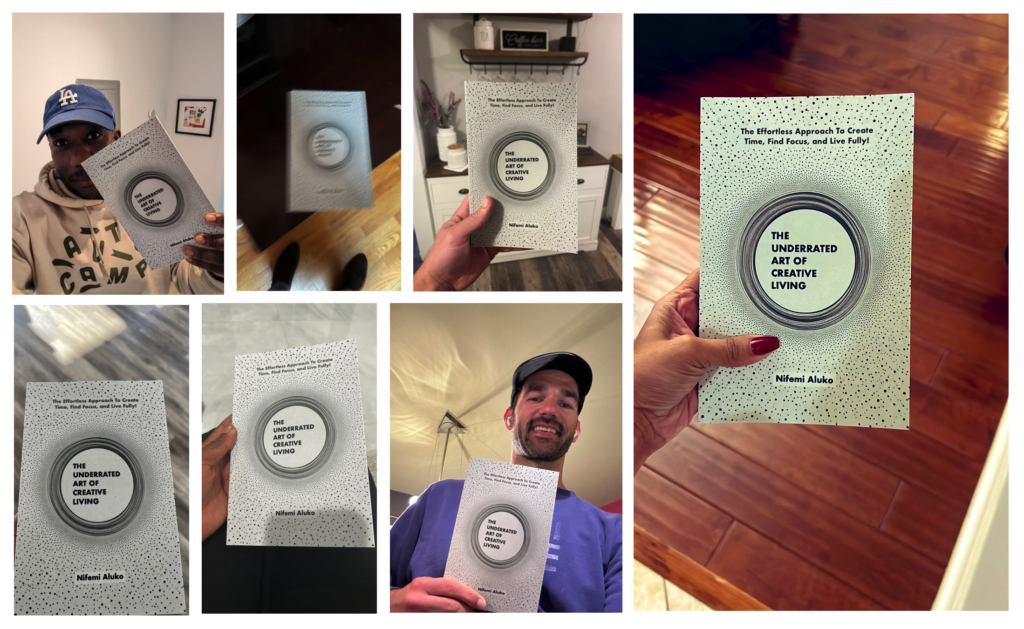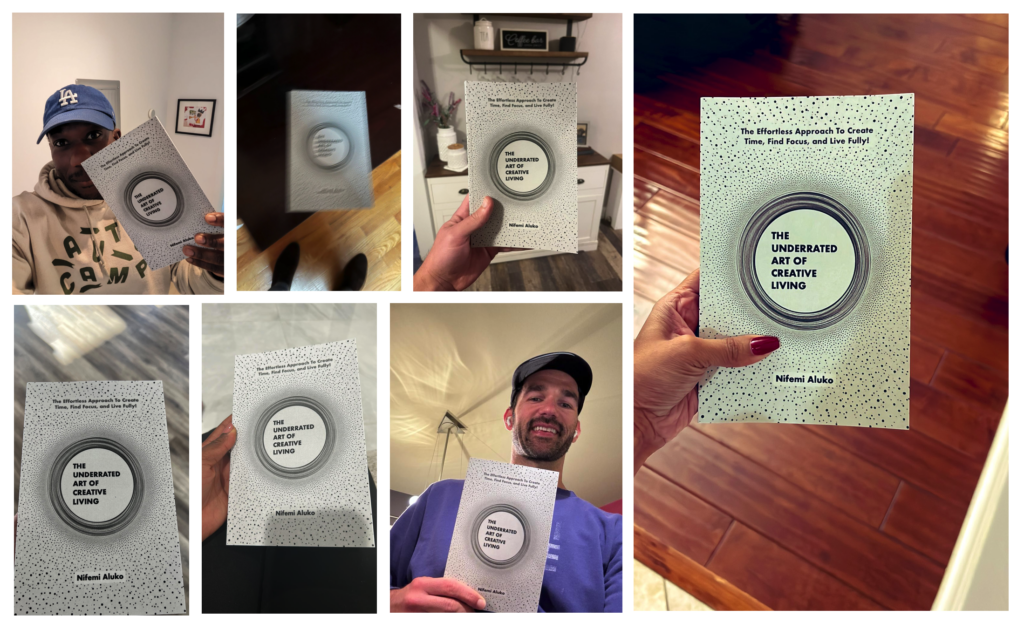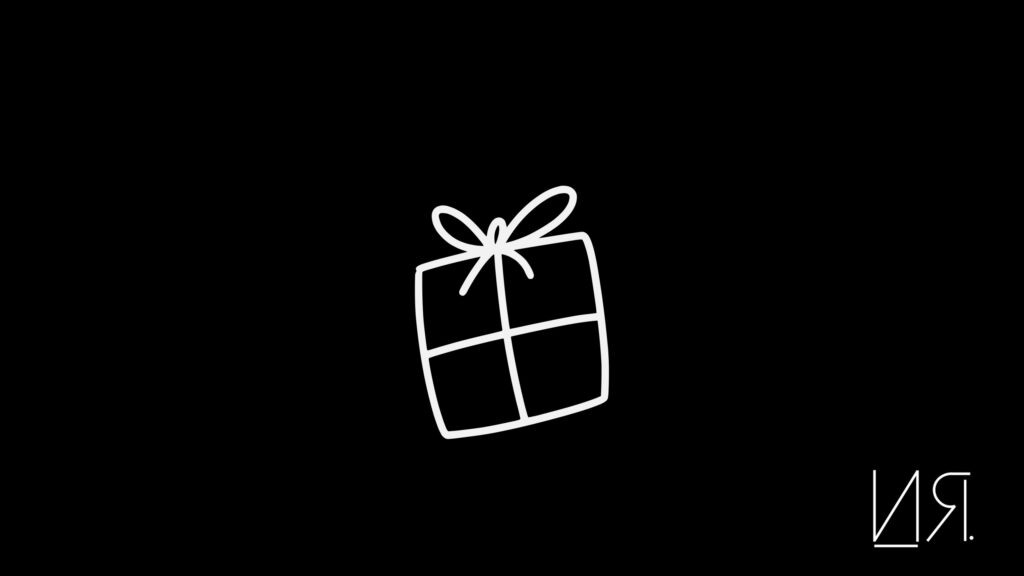Just before we get into the letter for the day.
Come unlock the flow of writing along with me and a few other multifaceted people with a 30-day writing challenge.
Use it to reflect, get clarity, and build your creative confidence as we gear up for the new year.
Now back to our regularly scheduled program.
A few people have got my latest book in the mail.
In case you missed it, I sent you a free copy that you can download. Just search for “I have a gift for you” from me.
I started off writing this book as a free resource for my website.
It was supposed to be just a few pages long.
By the time I had outlined the manuscript and put a few ideas together, I had that moment of “what if I just wrote a full book” in the shortest amount of time as possible.
I went from one evening to a full weekend, to a few hours during the work week, and three weeks later—BOOM, I had a book.
Today, I want to share that process with you.
Just Book It
Most people want to make an impact but don’t know how.
The easiest way to make an impact in our capitalist world is to accumulate capital and then deploy it to influence people and decisions to build the world we want.
So a lot of people just focus on “making the money”.
And there is a lot of impact to be made this way. Taking care of your family. Having resources to provide a better life for the people you care about.
The problem with this type of impact is that it’s so singular and delayed. Most people only know one way to rise to the top.
Most of us, without proper questioning and reflection, get corrupted along the rise.
When you do “make the money” you end up not knowing what to do with it.
Hol’ up. Hol’ up. Hol’ up.
I hear the corporate strategists with their newly-minted Linkedin profiles, knocking on my door.
“Yes. Can I help you?”
“Easy for you to say, “Mr. Writer,” you must not have real problems.”
“Can you explain what fake problems are?”
“Ain’t you a wise guy. OK. OK. To be real. I want to create, write, make an impact but I just don’t have the time?”
“Have you watched the new “Got Gotti” series on Netflix?”
“Errmmm, yeah.”
“Got you. I knew you had time. You just don’t have time for some of the things you say you care about.”
“Bye, Felissshhh” *door closed*
Where was I? Oh yeah – impact.
Wait to rise to the top.
OR
Another approach is to clarify the impact you want to make and start sharing it now.
A good way to do this is by teaching and sharing your knowledge.
A great way to capsule your knowledge is to put it inside a book.
Books are very easy to write.
Well, let me tread lightly here.
They are easy and hard at the same time. Easy because anyone can write and the cost of production has been dramatically reduced.
It’s hard because it requires discipline and organization. Something a lot of us struggle with.
Writing a book can really drive your impact. It is ordered information that can really help people learn from your perspective.
Let me tap into your selfish gene. Not only does it help others, it helps you – the writer.
It is a point of reflection that brings clarity and allows you to crystalize your thoughts.
It also helps you find what’s important to you and locate like-minded people (your tribe).
A book can drive your impact and you can write it in less than 3 weeks.
The 47-hour Book
That’s not just a catchy name for a book. That’s the cumulative number of hours it took me to write my last book. The one in the picture above.
I wrote it as a challenge and I want to share each step of the process with you so you can think about how to do the same for yourself.
With this knowledge, you’ll debunk the writing and publishing process.
You’ll write because it helps you gain clarity while exploring topics that you’re actually interested in learning.
You’ll cultivate the habit of creating something that can impact the lives of others.
Here are the 7 steps it took me to get there (you can swipe them for your next book):
1. Take Notes
Timeline: On-going.
Writing is like sculpting.
You chip away at a first draft until the true story reveals itself.
But before you start sculpting, you need to gather the raw material.
Do this by reading and consuming things you’re interested in.
- Books
- Tweets
- Quotes
- Podcasts
- Audiobooks
I had about 400 notes this year before I thought about writing something.
Write notes around your interests. This is also a place to get clarity on your interests. With time you would get a sense of where the critical mass of ideas build up.
They are the raw material for your bestseller.
2. Start Defining
Timeline: 45 minutes
Without definitions, you wouldn’t know what done looks like.
It’s easy to keep writing.
As my editor said: “writing is never done”
Curb this need to write forever by having the end goal.
For this book, I wanted to create a free resource that would provide value to anyone who wanted to tap into the benefits of living a more creative life.
I started off by answering these 5 questions
- What “big problem” am I solving in the world?
- How can I solve that problem as quickly as possible for someone?
- Why does someone need this solution NOW?
- What is the story nobody else is telling about this problem?
- Why are you so concerned with solving the problem
The answers to these questions stayed on the first page of the document.
Every time I opened it up to write, I would look at my answers.
I edited my answers over time, as the book evolved. It was like the compass I needed to keep my writing on track.
Define who would benefit from what you are writing. Start with the problem you are solving first and then write about it.
3. The Friday Outline
Timeline: 30 minutes
What you need to move forward with your book is structure.
Once I had my guide, I created an outline.
I did a 15-minute exercise of just writing down bullet points of ideas that came to mind based on how I’d solve the problems listed in the previous step.
Set a timer and just write, bullet point after point.
This is more of a brain dump of resources. Just think, if a friend asked you to solve the problem for them, what would you tell them?
Once the timer goes off. Stop writing.
It’s time to organize.
You’ll find ideas and bullet points that are pretty much the same. Start clumping them together.
A critical mass of the main ideas would start to emerge. For my book, I had about 5 – 7 main clusters of topics from (self-discipline to mindset to building community)
Perform an outlining exercise based on the problem your book solves.
This process is quite unique to non-fiction. If you were writing fiction or even a memoir, an engaging storytelling framework like the hero’s journey would be a good starting point.
4. The Weekend Manuscript
Timeline: 6 hours
It’s Saturday. Ayyeee!
“We’re going to the club right?” “No. I’m going to write my book”
*yawn* “boring!”
Don’t let Agent Smith and his cronies get you. Focus on your work.
Once you have a rough outline, it’s time to start putting the pieces together.
I was tempted to write from scratch based on each point in my outline.
Don’t do it. Please don’t do it.
Instead of brainstorming, I did what I call “note-storming.”
I opened up my note box and started filling out the sections in my outline with my notes.
This is where the real benefits of note-taking come into play. Your note-box is an external brain that you can look at and examine.
Even better, with digital note-taking apps, you can search for ideas that you’ve stored away.
This created my first rough draft of 21,382 words.
Don’t start from scratch all the time. Use the notes you’ve been taking.
5. The 80/20 Editing Principle
Timeline: 22.5 hours
Now you have a rough draft, it’s time to refine.
Refine by captivating hooks and cutting out unnecessary stuff.
Remember this:
- The goal of the first line is to get the readers to read the next line.
- The goal of the first chapter is to get them to read the next chapter.
Based on this simple logic, the easiest way to lose attention is with a lackluster beginning.
Use the 80/20 rule of editing.
Spend 80% of your time editing the first 20% of your manuscript.
Do this for each chapter and section too.
This is where you make sure each title is captivating. Every start of the section is engaging. Pull in quotes and images to support your writing. End with strong takeaways.
Everything else that doesn’t fall in this first 20%, I labeled as the cold zone. Cut. Cut. Cut.
This method saves time and gets to the point.
Focus your editing on the most important part of your book.
6. The 12-hour Design
Timeline: 12 hours
I think of books like furniture. They are going to be an addition to someone’s home.
Build it with care.
People are nice; they don’t judge a book by its cover.
Just joking. Of course, they do.
A lot of people buy books simply because of the way they look. So don’t skimp on the design.
For the internal design and layout, I imported my wall of text into Adobe InDesign. There are templates you can use, ready to go. I tweaked mine a bit to get what I wanted.
I exported the entire book, all 200 pages, into a PDF and epub (for ebooks) format.
Voila!
7. The Marketing Wheel
“This a Rollie, not a stopwatch, sh*t don’t ever stop”
Drake must have been talking about marketing when he dropped those lines.
Marketing never stops. Sales is daily hand-to-hand combat.
Let me start by asking: “Is it really a book if no one reads it?”
Before the philosophers answer, let me take a stab at it: you need readers.
Now that you have your book. You have to get it into the hands of your readers. There is a whole different letter or even book that can be dedicated to this.
Here are a few tips:
- Market before your book comes out. Share the behind-the-scenes process.
- Share your inspiration. What books influenced you when writing? Authors like to share images of their book stacks.
- Set up a pre-order page, to get people to buy in before release.
- Give away the summary or a free chapter of the book. Getting email addresses might be more important than sending people to a website to buy (where you can’t stay in touch with your readers).
Also, remember the answers to those 5 questions in step 2? That’s the basis for your marketing copy.
Marketing is a non-stop wheel.
Make sure you are building and curating your 1000 true fans. Find unique ways to stay in touch and build your book brand.
Timeline: non-stop
Final thoughts
When I started out, the plan was to create a lead magnet for my website.
All I wanted was a few pages to provide some tips on embracing a creative life.
I ended up with more than that. So I sent out free ebook copies to my mailing list to download.
Then I took it a step further. I found a printer in Los Angeles, who printed a few copies of the book.
Now I have physical copies to send out.
You can take your PDF, get an ISBN number, and upload your files to Amazon directly.
That’s what I did for my first two books. I tried something different this time.
Publishing a book is easier than you think. It can drive your impact.
Start writing. Get published. Engage readers.
You have a unique story. Go tell it.
Yours truly, Nifemi




